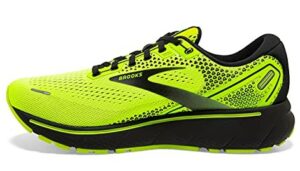For many years, scientists have been trying to pinpoint values and levels to measure against in order to understand what drives human performance. Not just in sports but also in day-to-day life scenarios and looking at patients recovering from various illnesses, these values or thresholds can come in handy in a multitude of ways. If you want to measure your running fitness and pick baseline numbers from which you can improve, then knowing your aerobic and anaerobic threshold values, as well as some other useful terms, can be beneficial.
What is anaerobic threshold, what is the difference between it and a lactate threshold, aerobic threshold, or ventilatory threshold even, and how do all these measurements help you achieve your running training goals?
Although most literature around run training and speed improvements will include some information on the thresholds among other discussions of aerobic capacity, interval training, etc., in this article, we’ll focus specifically on the metrics themselves and how they impact your performance. Whether you engage in heavy exercise or are a casual runner, we’ll see how you can train using your anaerobic threshold, and finally, how you can get faster and fitter thanks to measuring and tracking these metrics.
What is Anaerobic Threshold?
When you work out, your heart rate increases, your muscles are getting blood pumped into them, and the intensity at which you’re moving determines a level of fatigue depending on your fitness levels. The consequences of exercise on your cardiovascular system and your muscles have been measured using levels at which you can no longer sustain the activity you’re engaged in.
The anaerobic threshold is the highest exercise intensity that you can sustain for a period of time without lactate building up in your blood to the point where you cannot continue.
Logically, if you’re able to train your body so that your anaerobic threshold is pushed back, then you’ll be able to go faster and harder for longer. But, how can you measure this point, and what other variables can you use to build a relevant training plan that uses high-intensity exercise to develop muscular and cardio fitness?
The concept of anaerobic threshold
It’s useful to understand the scientific terminology and how each of the most used measures reflects the level of effort you put in during your runs. However, bear in mind that sports scientists actually do not all agree on these thresholds and how the body’s use of energy during exercise really works.
The concept of anaerobic threshold was developed to define the point at which metabolic acidosis and the associated changes in gas exchanges in the lungs occur during exercise. To put it another way, during incremental exercise (so where your effort goes slowly upwards), at a certain intensity, you’ll arrive at:
- a steep increase in ventilation – also known as the ventilatory threshold (or ventilatory anaerobic threshold);
- a non linear increase in blood lactate concentration – also known as the lactate threshold;
- a non linear increase in CO2 production;
- an increase in end tidal oxygen;
- an onset of blood lactate accumulation;
- and an abrupt increase in expired O2 fraction.
All these elements together have been combined by researchers and labeled as anaerobic threshold. This tells us that another term we often hear when looking at training, the lactate threshold, is part of the anaerobic threshold.
The role of the anaerobic threshold in endurance sports is controversial. Still, training at or a little above anaerobic threshold intensity is known to improve both the aerobic capacity and the anaerobic threshold level. You can read more about these terms and their scientific foundations here.
Anaerobic vs aerobic metabolisms
Looking at how energy is used during your runs or exercise, we basically refer to two types of metabolism: aerobic and anaerobic. Understanding these will give you a better idea of why we talk about an anaerobic and an aerobic threshold.
The anaerobic metabolism is the creation of energy from carbohydrates in the absence of oxygen, so when your lungs aren’t pushing enough oxygen into the bloodstream to feed your muscles’ demand for energy. In “real life,” this happens when you’re sprinting during a cycling or running workout or when you lift heavy weights.
On the other hand, aerobic metabolism refers to how your body creates energy by burning carbohydrates, amino acids and fats in the presence of oxygen. You’re using your aerobic metabolism when you do a longer, steadier pace form of exercise like running, biking or walking.
It’s important to understand that our bodies are complex systems, and they don’t ever use just one form of metabolic process to produce energy. So, at any given time, there is a constant exchange during exercise between your lungs, your bloodstream and your muscles, and – depending on the pace and level of effort – different processes work harder than others.
What Is Lactate?
As we’ve mentioned already, we talk about lactate and anaerobic threshold, but there is confusion and debate about what these are and what lactate even is. Initially, scientists used to believe that blood lactate production was a waste process during anaerobic exercise. Lactate studies date back to the 19th century, involving Nobel Prize winners such as Louis Pasteur, so it’s been a topic of discussion for quite some time.
Nowadays, we know that blood lactate production can occur under aerobic conditions, and we also know that it’s not a waste product. According to Dr. George Brooks, a metabolism expert from the University of California at Berkeley, c. 30% of the glucose we use during exercise is derived from lactate “recycling” to glucose.
There are also some other interesting connections with lactate, such as correlations between blood lactate and long-term memory and brain functions that could even connect to understanding and treating Alzheimer’s disease. Finally, those suffering from type 2 diabetes have 2-3 times higher concentration of lactate in their blood than healthy people. So, you can see how lactate can be a major element in our metabolism beyond the way our body reacts to incremental exercise and effort levels and is crucial to understanding different chronic diseases.
How To Enhance Your Anaerobic Threshold
Coaches and sports scientists talk about developing your anaerobic threshold and delaying the onset of too much blood lactate accumulation through interval and tempo training. The easiest way to incorporate these in your workouts, knowing that you’re training in the right zones, is to use heart rate training.
Tempo runs are the most popular session for increasing the lactate threshold and developing longer-term power and endurance. A good tempo session is at or just below threshold, i.e., your Zone 4 Heart Rate, where you can sustain the pace for a good amount of time (at least 10-20 minutes) and increase incrementally throughout your workouts.
Here’s an example:
- Warm up at an easy pace (Heart Rate Zone 1) for 15-20 minutes
- Include a few drills such as fast feet, strides, etc. (check out some examples in this article)
- Run 20 minutes tempo effort aiming to reach and hold HR Zone 4 throughout
- Cool down 20 minutes.
In time, you can progress to a 30-minute tempo session, then 40 minutes.
Training Tips For Faster Running
If you’re looking to increase your running speed and efficiency, especially when preparing for a race or endurance event, you’ll probably be looking for a structured training plan with sessions that cater to your particular goals. These need to take into account your fitness levels, your aims and abilities and personal availability (i.e., how many workouts you can fit in, when, how often etc.).
Our advice is not to get stuck into the concepts of anaerobic and aerobic capacity, concentration of lactate and so on. Instead, include a mix of workouts into your running training plan, which will aim to boost your aerobic capacity through longer, easy pace runs, as well as work on your speed and explosive power thanks to sprints and running drills.
Here are a few top tips for building your bespoke training plan:
- Be very clear about the aim of each run you do. Include recovery runs at a slow, comfortable pace, where you can work on your breathing and running form, as well as faster-paced interval sessions. Remember that not every run needs to be a hard run!
- Do at least one speed session a week. Start off with shorter intervals – on a running track if you can – and build from there.
- Do one long run which increases steadily in distance every week, without jumping too far too quickly. Give your body time to adjust so start back from your race date and make sure you’re going to have enough weeks to prepare for your event properly to avoid injury risks.
- Use periodization: two or three weeks building up intensity and volume, followed by one week of recovery where you dial down your running volume and allow your body to adapt.
- Don’t neglect strength training. Your muscles and your running form will thank you for it.
You can learn more about speed training sessions in our article here, as well as how to build your marathon training plan here.
To help guide the intensity of your runs, here’s a guide about heart rate training and how each zone corresponds to different adaptations within your body.
Conclusion: Using A Mix Of Workouts To Improve Your Running Speed and Endurance
Finding the exact point at which an increase in blood lactate impacts your running efficiency to the point that you can no longer sustain your current pace has been a focal point of research for sports scientists for years. While the actual existence of a lactate threshold or anaerobic threshold is sometimes disputed, understanding how the aerobic and anaerobic metabolic systems work and their importance for your running performance will put you in a good position to include the right sessions in your training plans.
Ultimately, the key takeaway is that you should have both easy-paced recovery runs and fast-paced speed sessions, including intervals and tempo runs, alongside your long runs once a week. Having the right mix of sessions ensures you allow appropriate recovery time and develop your metabolic systems for both endurance and explosive speed.


























